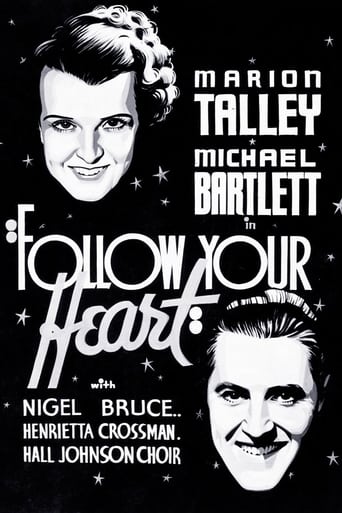Brenda
The plot isn't so bad, but the pace of storytelling is too slow which makes people bored. Certain moments are so obvious and unnecessary for the main plot. I would've fast-forwarded those moments if it was an online streaming. The ending looks like implying a sequel, not sure if this movie will get one
David Kelsey
Marion Talley was a star of the NY Metropolitan Opera. In this, her only film, she plays the sort of role which would soon become associated with Deanna Durbin, 15 years her junior. The leading man is Michael Bartlett, an operatic tenor not dissimilar to Allan Jones in voice, appearance, and style. Like Durbin and Jones, they present serious vocal music in a pleasantly popular format.A light-hearted mood is sustained by a supporting cast of reliable comic actors including Nigel Bruce as a bumbling voice coach, Josephine Whittell as his tone deaf pupil, Luis Alberni as an excitable composer/conductor, and Walter Catlett as an over enthusiastic impresario. Ben Blue provides the physical comedy.For the first 45 minutes the film romps along at a merry pace, in a style reminiscent of "Love Me Tonight" (even down to a hunting scene in which the hero saves the quarry from the hounds). Then the family decides to "put the show on right here." They demolish the barn to furnish seating for the audience, planning to stage the show on the porch, and one begins to hope that this might be an intentional parody of the sub-genre that Mickey and Judy would later make their own. Alas, all originality ends there, and the last half hour of the film drags as we are regaled with large parts of the performance. There are romantic duets by the two leads, a crinoline-clad corps de ballet led by an undistinguished prima ballerina, a comical pas de deux by Ben Blue with an uncredited partner, and the Hal Johnson Choir led by Clarence Muse accompanying an incongruous tap-dance by Eunice Healy in a costume surely intended for Daisy Mae in Li'l Abner. (In the 1930 Broadway production of "Girl Crazy" Miss Healy had been billed 6th in a cast which listed Ethel Merman and Ginger Rogers in 13th and 17th positions. After appearing in three Hollywood movies she returned to the musical stage, as a performer and later as a producer.) The unbelievably lavish production is greatly aided by the fact that the lawn between the old barn and the porch transforms itself effortlessly into a rotating stage with a mirror surface. No explanation is offered for this miracle, but when the company proposes to go on the road despite having no theatres to play in, their manager explains that "there's a house like this outside every city from Richmond to Memphis." In 1936 Hollywood was still experimenting with formulae for musical films. Warner Brothers favoured backstage plots, RKO provided escapist musical comedies for Astaire and Rogers, while Paramount and MGM presented regular musical revues in their "Big Broadcast" and "Broadway Melody" series. It would have been better if Republic had stuck to a single style for this film, preferably the one they started with. Instead they hedged their bets by trying a bit of everything, with unfortunate results. Still, the first hour of the film is worth the viewing.

